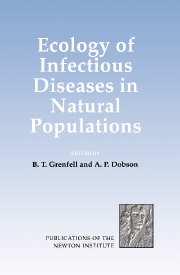Book contents
- Frontmatter
- Contents
- List of Participants
- Introduction
- BROAD PATTERNS AND PROCESSES
- Impact of Infectious Diseases on Wild Animal Populations: a Review
- Microparasites: Observed Patterns
- Mathematical Models for Microparasites of Wildlife
- Microparasite Group Report
- Macroparasites: Observed Patterns
- Mathematical Models for Macroparasites of Wildlife
- Macroparasite Group Report
- Critical Evaluation of Wildlife Disease Models
- PATHOGENS, INSECTS AND PLANTS
- IMPACT OF ECOLOGICAL AND GENETIC HETEROGENEITY
- Glossary
Mathematical Models for Microparasites of Wildlife
Published online by Cambridge University Press: 22 January 2010
- Frontmatter
- Contents
- List of Participants
- Introduction
- BROAD PATTERNS AND PROCESSES
- Impact of Infectious Diseases on Wild Animal Populations: a Review
- Microparasites: Observed Patterns
- Mathematical Models for Microparasites of Wildlife
- Microparasite Group Report
- Macroparasites: Observed Patterns
- Mathematical Models for Macroparasites of Wildlife
- Macroparasite Group Report
- Critical Evaluation of Wildlife Disease Models
- PATHOGENS, INSECTS AND PLANTS
- IMPACT OF ECOLOGICAL AND GENETIC HETEROGENEITY
- Glossary
Summary
Introduction
In this chapter we review some of the basic theory of deterministic modelling of microparasitic diseases of wild animal populations. As discussed by Dobson and Grenfell in the Introduction to this volume, the special feature of wildlife diseases is that host population size is a dynamic variable. This requires significant modifications to classical epidemic theory based on constant host populations. Particularly since the seminal work of Anderson and May (1979), there has been a large body of research in this area (reviewed by Barlow, Begon and Bowers, Briggs et al. (this volume)). Here we review some basic issues in the modelling of microparasitic infections in naturallyfluctuating animal populations. The paper is not intended as an in depth study of microparasite models, but should be seen more as a summer exhibition at a museum with little bits of everything, as a guide to the art of elementary modelling and the less accessible more mathematical literature where the exhibits are usually stored.
There are many purposes for using mathematical models in epidemiology (see Anderson and May (1991), Hethcote and Van Ark (1992) for an extensive list). Among the main ‘justifications’ are, firstly, the fact that models provide insight into the relative importance of factors that influence spread, and improve our understanding of the relationship between mechanisms that operate on the level of the individual and the phenomena that result on the population-level (after Diekmann 1991). Secondly, the formulation of mathematical models requires precision about the underlying hypothesis and could make one aware of working hypotheses that might otherwise go unnoticed and which, once discovered, might deserve scrutiny.
- Type
- Chapter
- Information
- Ecology of Infectious Diseases in Natural Populations , pp. 90 - 122Publisher: Cambridge University PressPrint publication year: 1995
- 28
- Cited by



